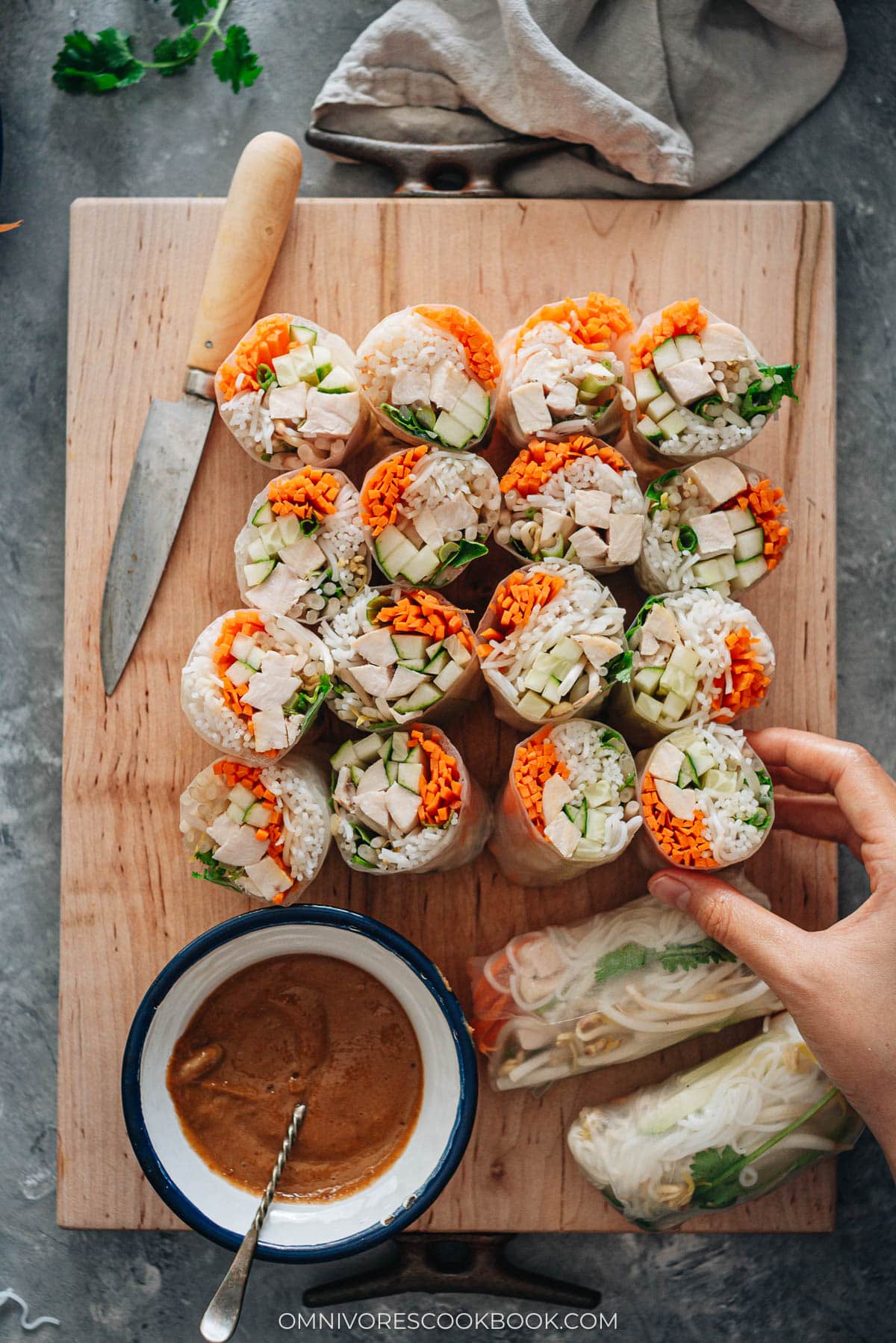
Chicken spring rolls is one of my favorite dinners on a hot day. Wrapped in delicate rice paper and filled with tender chicken, crisp vegetables, and fresh herbs, they’re refreshing, satisfying, and surprisingly easy to make at home.
Perfect for warm weather or whenever you’re craving something fresh but still nourishing, these rolls come together with minimal cooking and lots of room for customization.
What are rice paper spring rolls?
Unlike their deep-fried cousin chicken egg rolls, rice paper spring rolls—often referred to as Vietnamese-style spring rolls or fresh rolls—are served cold and not cooked after wrapping. The wrappers are made from rice flour and tapioca starch, and they soften quickly when dipped in water. Once pliable, they’re ready to be filled and rolled.
My version uses sliced chicken breast, crunchy veggies, and lots of herbs, all wrapped up in a light, chewy wrapper and served with a peanut spiced up with ginger, garlic, and chili oil.
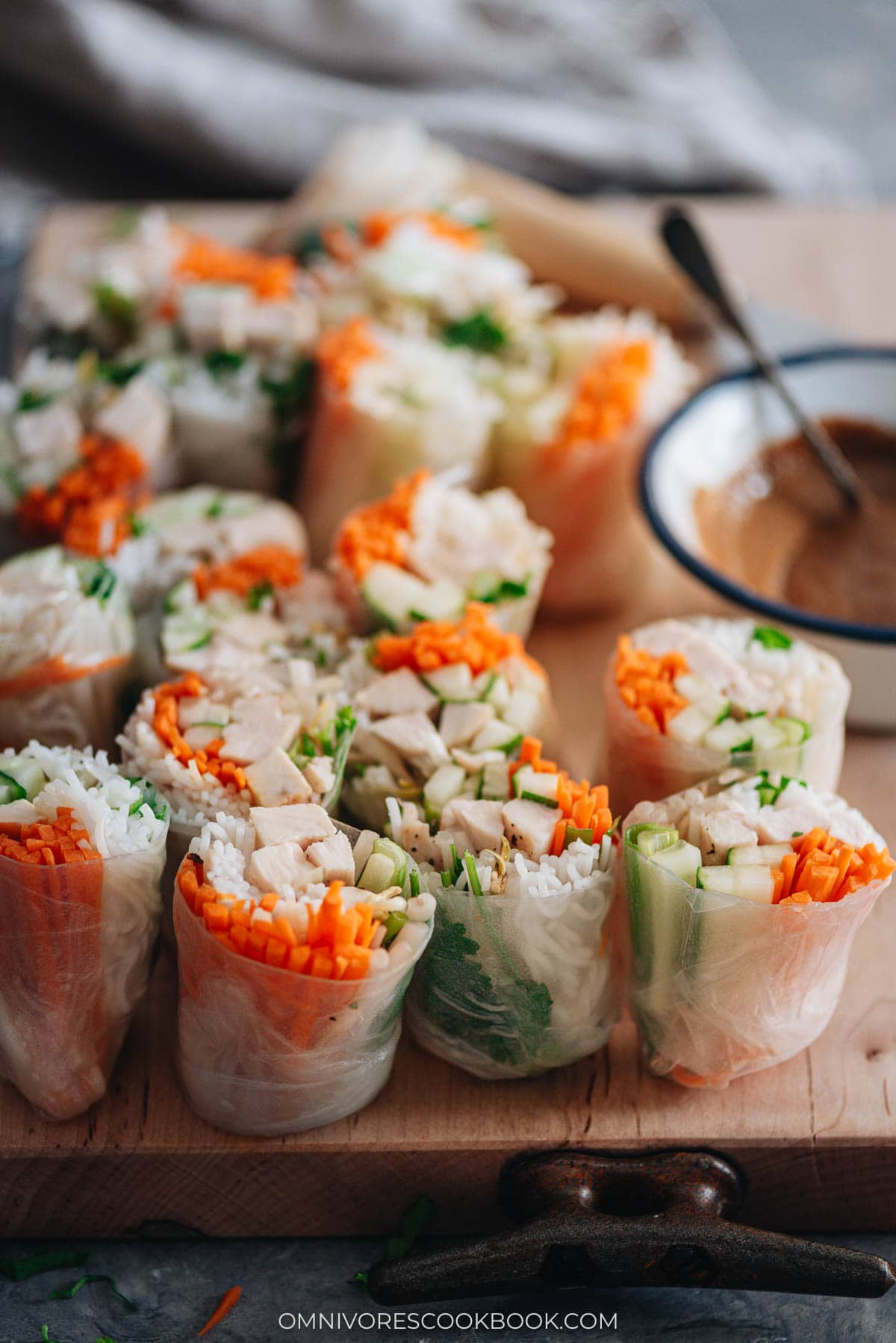
Ingredients
Rice paper
The key ingredient in this recipe is the rice paper wrapper. I prefer to use the type that is about 8″ (or 22 cm) in diameter. These are medium sized rice papers that are easy to work with, and they make a decent size roll that is packed with goodies.
You can get them at an Asian grocery store. Or you can order them on Amazon.
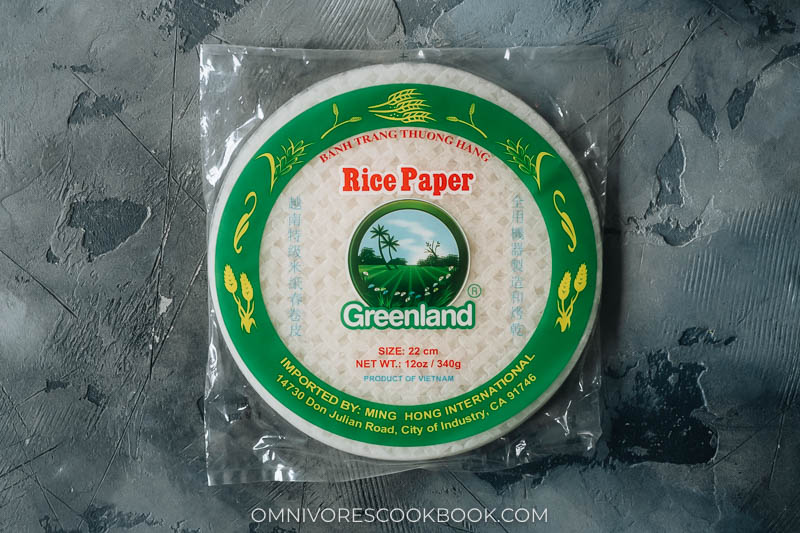
Vermicelli
I always love adding some rice vermicelli into my spring rolls, because it adds a fun crunchy texture. You can substitute any other type of vermicelli, such the ones made with potato starch or mung beans, whichever you happen to have on hand.
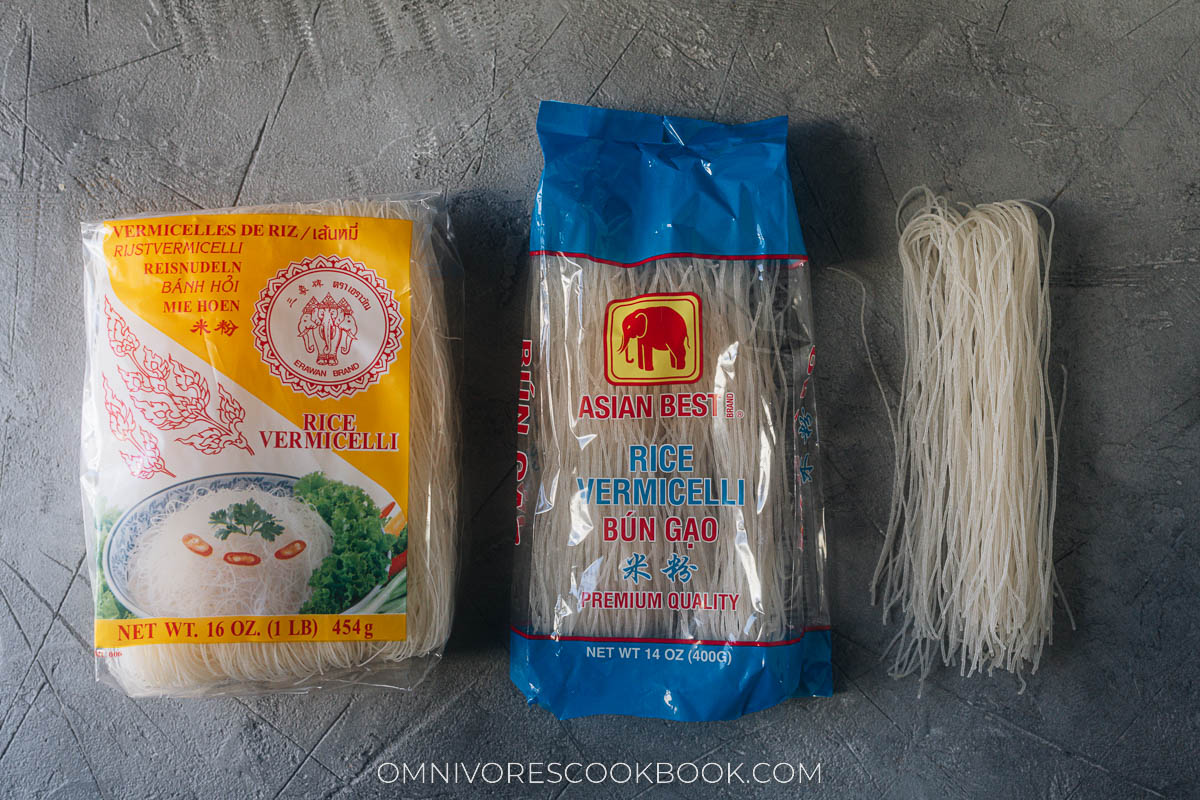
Vinegar
I prefer to use Chinkiang vinegar, or Chinese black vinegar, to add an earthy umami with a tangy taste to my peanut dipping sauce.
If you don’t have this ingredient, you can use cider vinegar for a fruity flavor, distilled vinegar if you like your sauce to be extra tangy, or rice vinegar if you prefer a mild zesty taste that’s slightly sweet.
Chili oil
Chili oil is another must-have ingredient in my peanut sauce. Not only does it add spiciness, it also adds a nice smoky flavor and tons of umami. When possible, make your own chili oil from scratch for the freshest taste. For a delicious shortcut, use Lao Gan Ma chili crisp for its intensive umami.
How to make
Cook the chicken
My recipe uses an oven roasting method that is easy and hands-off. If you do not like to turn on your oven in the summer, use my Instant Pot shredded chicken recipe, or the easy poaching method from my Yunnan lime chicken recipe.
If you do not want to cook the chicken yourself, shredded rotisserie chicken works perfectly, as well.
Prepare the vermicelli
Most vermicelli requires cooking in boiling water. Check the package instructions for the cooking time, because it can vary a lot depending on the product. Vermicelli expands a lot after cooking, and it can be hard to measure because the dried form is very lightweight. Since my recipe calls 2 cups cooked, you will only need a very small batch (less than 1 cup dried).
Mise en place
Before you start to wrap the spring rolls, make sure you have all the vegetables prepared and the vermicelli soaked.
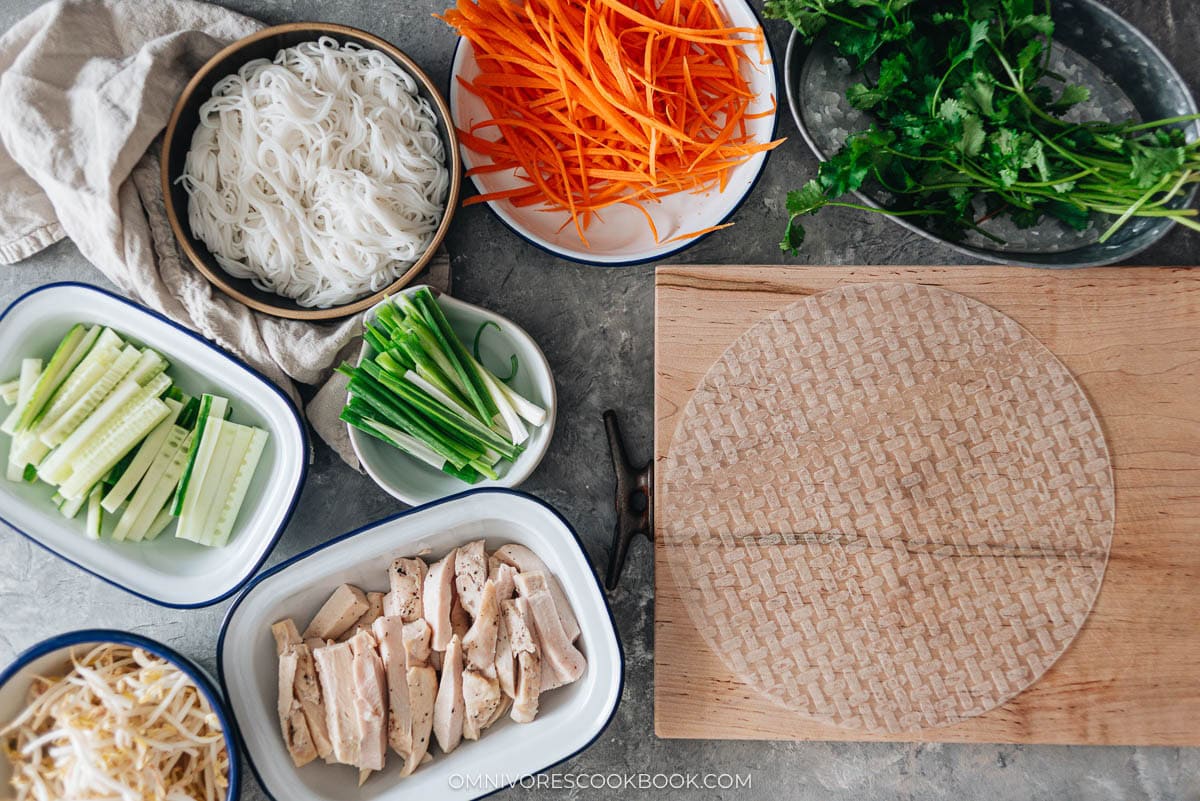
How to wrap the rice paper rolls properly
Soak the rice paper in warm water very briefly, about 5 seconds or less.
Assemble the roll by placing all the ingredients on the lower third, fold the bottom side up to cover the filling, then tuck in both sides and keep rolling up to the top. To make a nice presentation, you can slice the roll in the center before plating it.
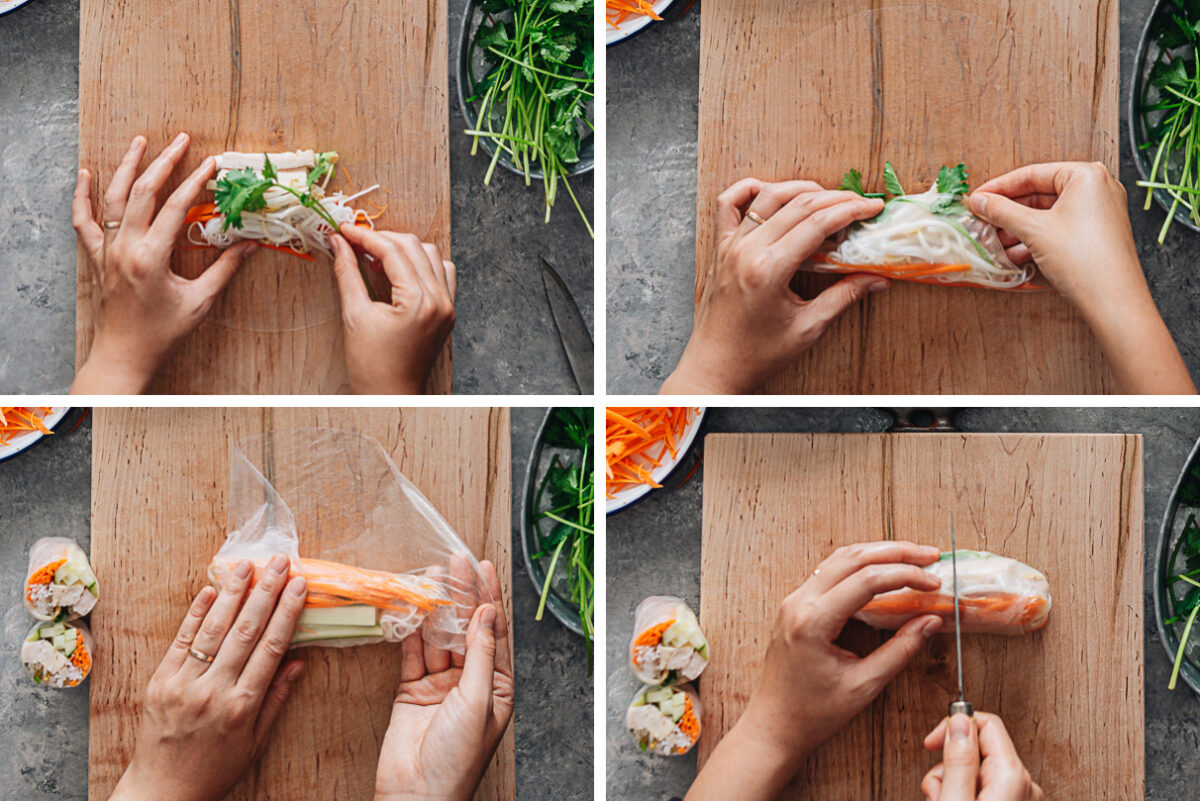
The best way to soak rice paper
It’s very important not to over soak the rice paper. When you soak the rice paper, you’ll notice that it remain stiff and holds its shape for a few seconds. It will be soft enough that you can bend it without breaking it, but not so soft that it collapses in your hand. That’s the time to take it out and assemble the roll, because it’s easier to work with. The rice paper will keep rehydrating even after it’s taken out of the water, and it will become very soft once the roll is assembled. If you soak the rice paper for too long, it will become too soft and will be difficult to work with.
How to create your own recipe
There are unlimited combinations of ingredients you can use in chicken spring rolls and they are all very delicious. You will need chicken, some crunchy vegetables (preferably with different textures), one ingredient with a tender texture, and some herbs.
- Chicken breast – you can replace it with leftover rotisserie chicken or boneless thighs.
- Vegetables – bell peppers, lettuce leaves, zucchini, and sliced radishes work well in this recipe. Feel free to add or subtract ingredients as you like.
- Herbs – adding one refreshing herb that is slightly spicy will help bring out the flavor of the rest of the ingredients. I chose green onion and cilantro. You can replace them with mint or basil, as well.
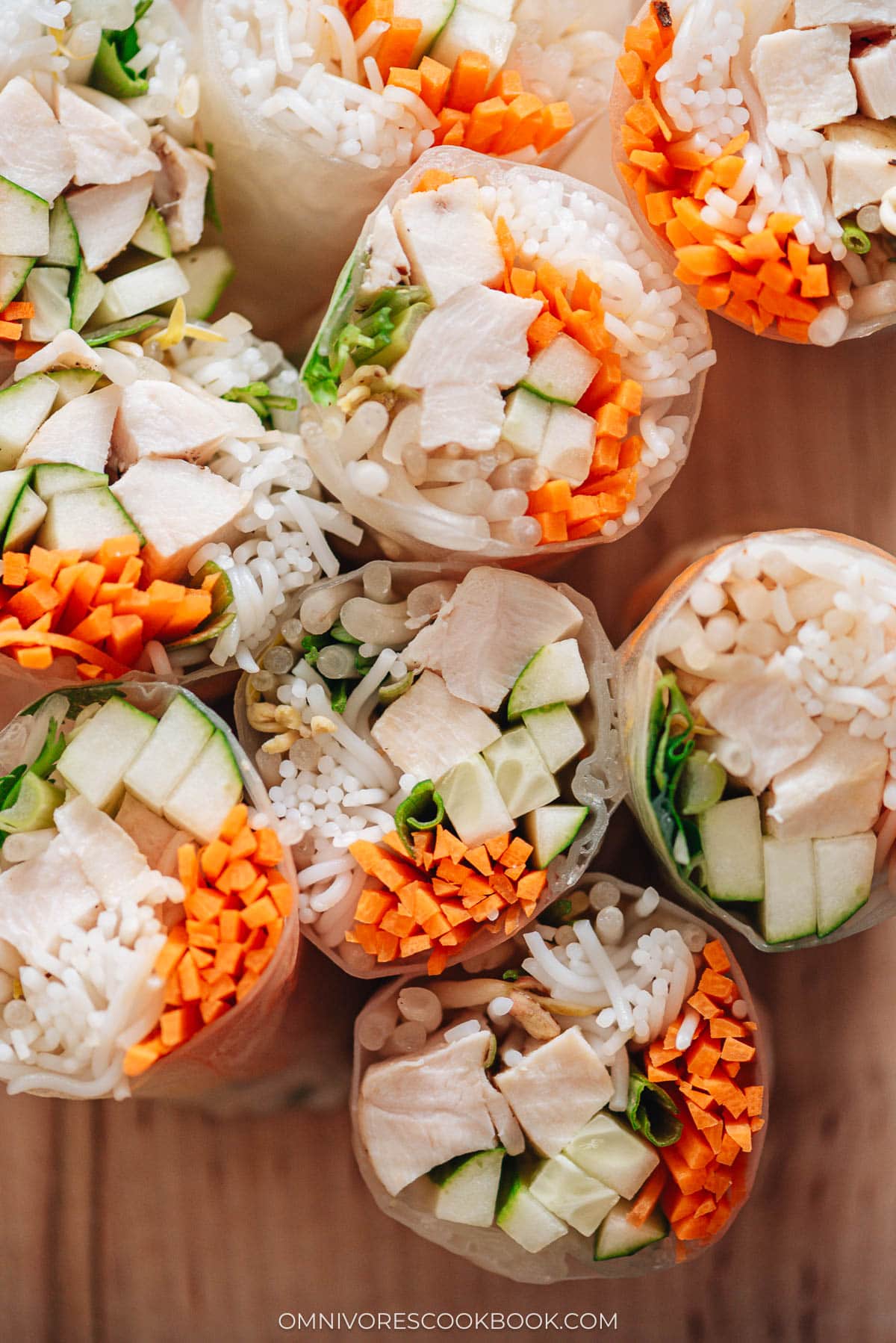
Frequently asked questions
Can I make rice paper spring rolls ahead of time?
These spring rolls taste best when they’re freshly made, but they will hold up well for a couple of hours. If you’re serving them for dinner or for a party, you can make them the same day you plan to serve them. Store the rolls on a big tray covered with plastic wrap. And only slice the rolls in half when you’re ready to serve them.
Can I refrigerate leftovers?
Yes, but the texture of the rice paper will become tougher the longer you store them. Overnight storage is OK. Wrapping them tightly in plastic wrap helps. Spritzing with a little water and letting them return to room temperature before eating can soften them slightly.
Why do my rice paper rolls tear when I roll them?
Tearing usually happens when:
- You over-soak the wrapper
- The filling is too bulky or sharp (e.g., pointy carrots that are too thick)
- You’re rolling too tightly without enough give in the wrapper
Try using less filling, not over-softening the wrapper, and rolling gently but firmly.
More warm weather recipes
- Yunnan Lime Chicken Salad
- Peanut Noodles
- Summer Vegetable Bibimbap
- Vegetarian Kimbap
- Black Sesame Ice Cream (No-Churn)
Chinese Cooking Made Easy
Are you new to this website? This free email series is a great place to start. I’ll walk you through a few of my most popular recipes and show you how and why they work. You’ll quickly start to cook better Chinese food in your own kitchen.
Watch video
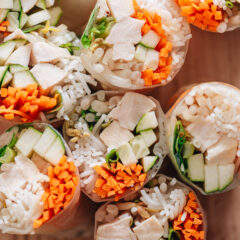
Chicken Spring Rolls with Peanut Sauce
Ingredients
Chicken
- 1 lb chicken breast
- 1 teaspoon vegetable oil
- 1/2 teaspoon salt
- 1/4 teaspoon black pepper
Nutty Sauce
- 4 heaping tablespoons unsalted natural peanut butter
- 4 tablespoons Chinkiang vinegar (*Footnote 1)
- 2 tablespoons light soy sauce (or soy sauce)
- 2 tablespoons maple syrup (*Footnote 2)
- 1 tablespoon sesame oil , toasted
- 4 cloves garlic , minced
- 4 slices ginger
- 2 to 3 tablespoons homemade chili oil (Optional)
Spring rolls
- 12 round rice paper wrappers (8" / 22cm)
- 1 English cucumber , cut into strips
- 3 carrots , shredded
- 2 cups bean sprouts
- 4 green onions , cut to strips
- 2 cups cooked rice vermicelli
- 1 small batch cilantro
Instructions
Cook the chicken
- Preheat oven to 450°F (230 °C).
- Line a baking sheet with parchment paper. Dry chicken breasts with a paper towel and rub with a thin layer of oil. Season both sides with salt and black pepper.
- Bake for 10 minutes for smaller pieces and 15 minutes for larger pieces, until the chicken is cooked through. (*Footnote 3)
- Set the chicken aside to cool. Slice or shred the chicken right before making the rolls.
Mix the sauce
- Combine all the ingredients for the sauce with 2 tablespoons of water in a tall cup and mix it into a smooth sauce using an immersion blender. (*Footnote 4) Let sit for 10 minutes so the flavors will blend.
Assemble the spring rolls
- Cut and prepare all the ingredients. Add warm water to a skillet or large plate that fits the rice paper wrappers.
- Work on spring roll wrappers one at a time. Dip one wrapper into the water for about 5 to 8 seconds until it turns soft enough to bend, but not entirely soft. The rice paper will continue to soften up while you work on the roll.
- Spread the wrapper on a cutting board or a big plate. On the lower third of the wrapper, add chicken, cucumber, carrot, bean sprouts, green onion, rice vermicelli, and cilantro.
- Fold the bottom side of the wrapper up to cover all the ingredients. Tuck both sides of the wrapper to seal the ingredients inside. Roll the ingredients towards the upper end, until they form a roll. Place the roll on a plate.
- Slice rolls in half. Serve with the nutty sauce as an appetizer.
Notes
- The sauce will taste best if you use Chinkiang vinegar. However you can replace it with rice vinegar, distilled vinegar, or apple cider vinegar.
- I like to use syrup in the dipping sauce because it creates a smoother texture. If you do not have syrup, you can use 2 tablespoons of sugar instead.
- The USDA minimum temperature for chicken is 165 F (74 C). However I usually cook chicken breast to 140 or 145 F, when the center just turns white. The chicken will be much tenderer and juicier this way, but also note that it increases the chance of foodborne illness.
- If you don’t have an immersion blender, grate the ginger and garlic with a microplane and whisk everything together in a medium-sized bowl.
Nutrition

Did you make this recipe?
I’d love to hear how it turned out for you! Please take a moment to leave a 5-star rating ⭐️ and share your thoughts in the comments further down the page. It really helps others discover the recipe too.

Bruce Cartwright
Spring rolls (Goi Cuon) are Vietnamese, not Chinese.
Jesse
I’ve been making goi cuon for about 10 years now. It used to be cheap to buy around here(oakland, ca), but the price has doubled most places. I’ve learned to make them better than the local places imo. Incredibly cheap too. We’re lucky to have several Vietnamese markets, some that get the fabled ‘3 ladies’ brand imported directly. The large rice paper packs from Vietnam cost $2.50 for a 15 pack. I think world market carries them, but not sure. Online they are $10 for some reason.
I have a tip I learned from a Vietnamese friend of mine that saves a ton of time- instead of soaking the rice paper, just quickly wet one side. By the time you assemble it, it’s soft enough to roll without cracking but not too soft. 10-15 minutes later, they’re perfect! They hold up well for hours as long as they’re covered.
I also prefer chicken to shrimp. One of these days I’m going to try flank or hangar steak…
Zrinka
I was wondering why I loved your style so much and then realised I resonated with your story. I fell in love with these wrappers and wondered how I didn’t discover them before. Thank you ❤️
Richard Wilson
Hi Maggie.
These rice paper rolls are called Goi Cuon in Vietnam and can be made with chicken as well as duck, pork, prawns or a pork mince called nem nuong. Being Australian with a Vietnamese wife, we have made them with kangaroo as well Delicious! You may like to try a dipping sauce called nuoc cham that is made with fish sauce.
It is good fun to let your guests assemble the rolls themselves while at the table.
I could eat a plate load of your’s right now. Very nice.
Richard.
Maggie
Hi Richard, thanks so much for sharing your knowledge on Vietnamese spring rolls! I’d love to try out the other fillings with different meat and dipping sauce. And what a great idea to let your guests assembling the rolls at the table! The rolls will definitely taste fresher that way 🙂
Joy
This looks yummy! Looking forward to more healthy recipes. Thanks!
Maggie
I’m glad to hear you like the dish Joy! More healthy recipes will be on the way 🙂